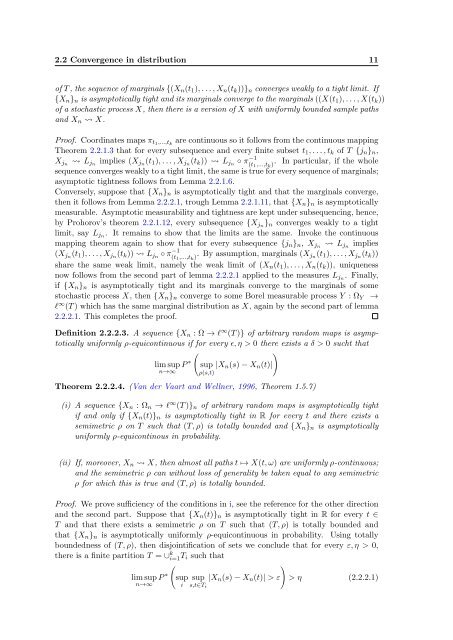Subsampling estimates of the Lasso distribution.
Subsampling estimates of the Lasso distribution.
Subsampling estimates of the Lasso distribution.
You also want an ePaper? Increase the reach of your titles
YUMPU automatically turns print PDFs into web optimized ePapers that Google loves.
2.2 Convergence in <strong>distribution</strong> 11<br />
<strong>of</strong> T , <strong>the</strong> sequence <strong>of</strong> marginals {(X n (t 1 ), . . . , X n (t k ))} n converges weakly to a tight limit. If<br />
{X n } n is asymptotically tight and its marginals converge to <strong>the</strong> marginals ((X(t 1 ), . . . , X(t k ))<br />
<strong>of</strong> a stochastic process X, <strong>the</strong>n <strong>the</strong>re is a version <strong>of</strong> X with uniformly bounded sample paths<br />
and X n X.<br />
Pro<strong>of</strong>. Coordinates maps π t1 ,...,t k<br />
are continuous so it follows from <strong>the</strong> continuous mapping<br />
Theorem 2.2.1.3 that for every subsequence and every finite subset t 1 , . . . , t k <strong>of</strong> T {j n } n ,<br />
X jn L jn implies (X jn (t 1 ), . . . , X jn (t k )) L jn ◦ π −1<br />
(t 1 ,...,t k ). In particular, if <strong>the</strong> whole<br />
sequence converges weakly to a tight limit, <strong>the</strong> same is true for every sequence <strong>of</strong> marginals;<br />
asymptotic tightness follows from Lemma 2.2.1.6.<br />
Conversely, suppose that {X n } n is asymptotically tight and that <strong>the</strong> marginals converge,<br />
<strong>the</strong>n it follows from Lemma 2.2.2.1, trough Lemma 2.2.1.11, that {X n } n is asymptotically<br />
measurable. Asymptotic measurability and tightness are kept under subsequencing, hence,<br />
by Prohorov’s <strong>the</strong>orem 2.2.1.12, every subsequence {X jn } n converges weakly to a tight<br />
limit, say L jn . It remains to show that <strong>the</strong> limits are <strong>the</strong> same. Invoke <strong>the</strong> continuous<br />
mapping <strong>the</strong>orem again to show that for every subsequence {j n } n , X jn L jn implies<br />
(X jn (t 1 ), . . . , X jn (t k )) L jn ◦ π −1<br />
(t 1 ,...,t k ) . By assumption, marginals (X j n<br />
(t 1 ), . . . , X jn (t k ))<br />
share <strong>the</strong> same weak limit, namely <strong>the</strong> weak limit <strong>of</strong> (X n (t 1 ), . . . , X n (t k )), uniqueness<br />
now follows from <strong>the</strong> second part <strong>of</strong> lemma 2.2.2.1 applied to <strong>the</strong> measures L jn . Finally,<br />
if {X n } n is asymptotically tight and its marginals converge to <strong>the</strong> marginals <strong>of</strong> some<br />
stochastic process X, <strong>the</strong>n {X n } n converge to some Borel measurable process Y : Ω Y →<br />
l ∞ (T ) which has <strong>the</strong> same marginal <strong>distribution</strong> as X, again by <strong>the</strong> second part <strong>of</strong> lemma<br />
2.2.2.1. This completes <strong>the</strong> pro<strong>of</strong>.<br />
Definition 2.2.2.3. A sequence {X n : Ω → l ∞ (T )} <strong>of</strong> arbitrary random maps is asymptotically<br />
uniformly ρ-equicontinuous if for every ɛ, η > 0 <strong>the</strong>re exists a δ > 0 sucht that<br />
)<br />
(<br />
lim sup P ∗ sup |X n (s) − X n (t)|<br />
n→∞ ρ(s,t)<br />
Theorem 2.2.2.4. (Van der Vaart and Wellner, 1996, Theorem 1.5.7)<br />
(i) A sequence {X n : Ω n → l ∞ (T )} n <strong>of</strong> arbitrary random maps is asymptotically tight<br />
if and only if {X n (t)} n is asymptotically tight in R for every t and <strong>the</strong>re exists a<br />
semimetric ρ on T such that (T, ρ) is totally bounded and {X n } n is asymptotically<br />
uniformly ρ-equicontinous in probability.<br />
(ii) If, moreover, X n X, <strong>the</strong>n almost all paths t ↦→ X(t, ω) are uniformly ρ-continuous;<br />
and <strong>the</strong> semimetric ρ can without loss <strong>of</strong> generality be taken equal to any semimetric<br />
ρ for which this is true and (T, ρ) is totally bounded.<br />
Pro<strong>of</strong>. We prove sufficiency <strong>of</strong> <strong>the</strong> conditions in i, see <strong>the</strong> reference for <strong>the</strong> o<strong>the</strong>r direction<br />
and <strong>the</strong> second part. Suppose that {X n (t)} n is asymptotically tight in R for every t ∈<br />
T and that <strong>the</strong>re exists a semimetric ρ on T such that (T, ρ) is totally bounded and<br />
that {X n } n is asymptotically uniformly ρ-equicontinuous in probability. Using totally<br />
boundedness <strong>of</strong> (T, ρ), <strong>the</strong>n disjointification <strong>of</strong> sets we conclude that for every ε, η > 0,<br />
<strong>the</strong>re is a finite partition T = ∪ k i=1 T i such that<br />
)<br />
lim sup<br />
n→∞<br />
P ∗ (sup<br />
i<br />
sup |X n (s) − X n (t)| > ε<br />
s,t∈T i<br />
> η (2.2.2.1)
















